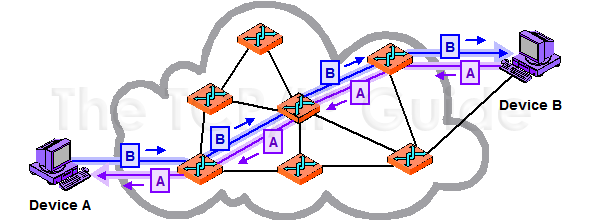- In this networking method, a connection called a circuit is setup between two devices, this is used for the whole communication
- Information about the nature of the circuit is maintained by the network
- The circuit may be fixed (always present) or create on an as-needed basis
- Even if many potential paths through intermediate devices may exist, only one will be used for data flow.

- In a circuit-switched network, before communication can occur between two devices, a circuit is established between them
- Shown as a thick blue line for the flow of data from Device A to Device B, and a matching purple line from B back to A
- Once setup, all communication between these devices takes place over this circuit
- The classic example of a circuit-switched network, is the telephone system
- When you call someone and they answer, you establish a circuit connection and data can be passed between you
- That circuit functions the same way, regardless of how many intermediate devices are used to carry your voice
- You can use it for as long as you need to, and then terminate the circuit
- The next time you call, you get a new circuit, which will most likely use different hardware than the first circuit did (depending on what’s available at that time in the network)
- Data passed between the connections in the order sent. Packets do not need to be re-sequenced as they pass in a linear, sequential way
